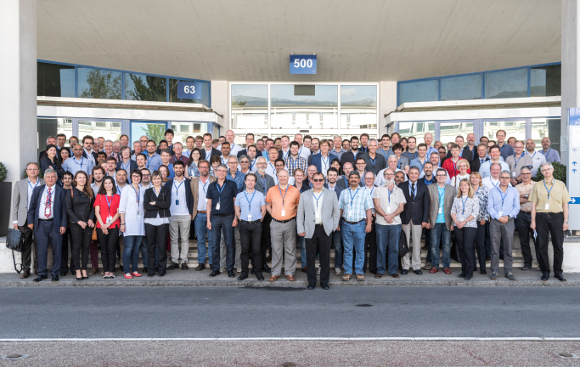By Eleonora Getsova (HEPTech)

Cryogenics has widely contributed to the recent major successes of High-Energy Physics (HEP). And conversely, HEP has pushed cryogenic engineering developments to a high level of technical excellence. The third European Cryogenics days, hosted by CERN on 9th and 10th June 2016, were focused on the latest developments in Cryogenics and laid grounds for further cooperation between academia and industry in this field.
Organizer of the event that brought together 176 participants, mostly from Europe, was the Cryogenics Society of Europe together with the High-Energy Physics Technology Transfer Network (HEPTech) and CERN, in partnership with the Enterprise Europe Network.
The forum explored topics relating to large cryogenic systems for HEP accelerators and detectors, instrumentation for cryogenic systems, research in the cryogenic field revealing examples of fundamental and applied projects, and future of cryogenics – covering developments in HEP, cryotherapy and space applications.
The talks dedicated to cryogenics for accelerators and detectors gave an overview of the structure of and experience with the cryogenic systems of the Large Hadron Collider (CERN), Wendelstein-7X stellarator (Max Planck Institute of Plasma Physics), the European X-ray Free Electron Laser (DESY, Germany) and the U.S. ITER central solenoid module, and highlighted problems and solutions relating to their installation, commissioning and operation. Lessons learnt from ATLAS and CMS – the two detectors of the LHC machine that use dedicated cryogenic equipment – addressed the most noticeable shortfalls, including oil contamination, experienced with each of them as well as the remedy modifications realized. Cryogenics of the European Spallation Source (ESS) target was explored and it was pointed out that the integrated moderator/hydrogen/helium system is currently being implemented.
Industry introduced novel membrane cryostats for large volume neutrino detectors to be used by CERN to detect interactions between neutrinos and argon atoms.
What makes cryogenic helium so beneficial in turbulence studies and what is the price to pay on the instrumentation side? These issues were the essence of a presentation on the GreC experiment showing preliminary results obtained. The experiment is hosted in SM I8, the CERN main cryogenic test facility, and is probing ultra high-intensity turbulence.
Both academia and industry presented latest developments in the cryogenic instrumentation, such as usage of superconducting devices for metrology and general instrumentation, optical fiber sensors for cryogenic applications, Coulomb Blockade Thermometer as a primary device for sub-kelvin measurements, specifics of the cryogenic instrumentation at CERN depending on the availability of radiation, and application of the Pressure Equipment Directive (PED) on the design codes for cryogenic equipment.
An overview of the research in the cryogenic field covered current research topics at the CERN’s Cryolab in the field of He II, such as heat transport studies in confined superconducting Rutherford cable geometries, options to localize a Quench spot at superconducting radio-frequency cavity surfaces as well as visualized effects of He II heat transfer mechanisms. Different material property test stands and cryocooler based zero boil off cryostat solutions were also discussed. Results of studies of the heat transfer at a sapphire – indium interface in the 30 mK – 300 mK temperature range were presented as well as examples of extreme conditions sample environment used in ISIS neutron scattering experiments at the Rutherford Appleton Laboratory (STFC), including ultra-low temperatures, high magnetic fields, high pressure and cryogenic environment for soft matter samples. Current experimental and theoretical work on cryogenic safety was also explored.
Future cryogenic applications addressing both needs of the fundamental research and applied science were discussed in the second day of the event. HEP research efforts will be concentrated on the development of dedicated cryogenic systems for the High-Luminosity LHC, under construction at CERN, and the Future Circular Collider (FCC), under study. It is clear already that the FCC cryogenic system will require cryoplants far beyond the present state-of-the-art with unit capacities of 100 kW at 4.5 K equivalent including 12 kW at 1.9 K.
Exposition of parts of the human body or the whole human body to cryogenic temperatures and the implying effects are in the core of the advanced cryogenic applications for medical purposes, health and well-being. Identification and development of enabling technologies for re-ignitable cryogenic upper-stages of future rocket launchers will be a breakthrough in usage of cryogenics for space applications at the European Space Agency.
Participants enjoyed the visits of the cryogenic systems at LHC point 1.8, the upper 18 kW cold-box and its corresponding compressor station as well as two 125 m3 liquid helium storage tanks, the CERN Large Magnet Facility, and the Central Cryogenic Laboratory where they had a look at normal helium in a glass cryostat being brought to its superfluid state and explored the Superconducting Cable Test Facility.
The event was accompanied with an industrial exhibition and bilateral brokerage meetings to enable the contacts and future cooperation between the representatives of academia and industry who valued the forum as a major step forward to strengthening of the European cryogenic community. The brokerage event was organized by Enterprise Europe Network, and is part of every European Cryogenics days.